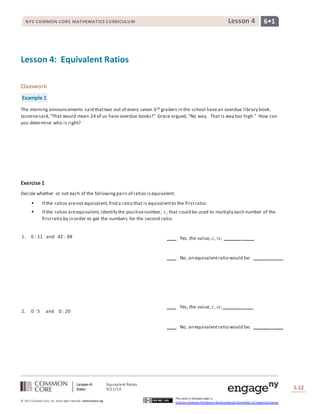
G6 m1-a-lesson 4-s
- 1. NYS COMMON CORE MATHEMATICS CURRICULUM Lesson 4 6• 1 Lesson 4: Equivalent Ratios Date: 9/11/14 S.12 © 2013 Common Core, Inc. Some rights reserved. commoncore.org This work is licensed under a Creative Commons Attribution-NonCommercial-ShareAlike 3.0 Unported License. Lesson 4: Equivalent Ratios Classwork Example 1 The morning announcements said that two out of every seven 6th graders in the school have an overdue library book. Jasmine said, “That would mean 24 of us have overdue books!” Grace argued, “No way. That is way too high.” How can you determine who is right? Exercise 1 Decide whether or not each of the following pairs of ratios is equivalent. If the ratios are not equivalent, find a ratio that is equivalent to the first ratio. If the ratios are equivalent, identify the positive number, 푐, that could be used to multiply each number of the first ratio by in order to get the numbers for the second ratio. 1. 6 : 11 and 42 : 88 2. 0 : 5 and 0 : 20 ____ Yes, the value, 푐, is: _______ ____ ____ No, an equivalent ratio would be: _______ ____ ____ Yes, the value, 푐, is: _______ ____ ____ No, an equivalent ratio would be: _______ ____
- 2. NYS COMMON CORE MATHEMATICS CURRICULUM Lesson 4 6• 1 Lesson 4: Equivalent Ratios Date: 9/11/14 S.13 © 2013 Common Core, Inc. Some rights reserved. commoncore.org This work is licensed under a Creative Commons Attribution-NonCommercial-ShareAlike 3.0 Unported License. Exercise 2 In a bag of mixed walnuts and cashews, the ratio of number of walnuts to number of cashews is 5:6. Determine the amount of walnuts that are in the bag if there are 54 cashews. Use a tape diagram to support your work. Justify your answer by showing that the new ratio you created of number of walnuts to number of cashews is equivalent to 5:6.
- 3. NYS COMMON CORE MATHEMATICS CURRICULUM Lesson 4 6• 1 Recall the description: Two ratios 퐴: 퐵 and 퐶: 퐷 are equivalent ratios if there is a positive number, 푐, such that 퐶 = 푐퐴 and 퐷 = 푐퐵. Ratios are equivalent if there is a positive number that can be multiplied by both quantities in one ratio to equal the corresponding quantities in the second ratio. This description can be used to determine whether two ratios are equivalent. Lesson 4: Equivalent Ratios Date: 9/11/14 S.14 Lesson Summary © 2013 Common Core, Inc. Some rights reserved. commoncore.org This work is licensed under a Creative Commons Attribution-NonCommercial-ShareAlike 3.0 Unported License. Problem Set 1. Use diagrams or the description of equivalent ratios to show that the ratios 2:3, 4:6, and 8:12 are equivalent. 2. Prove that 3:8 is equivalent to 12:32. a. Use diagrams to support your answer. b. Use the description of equivalent ratios to support your answer. 3. The ratio of Isabella’s money to Shane’s money is 3:11. If Isabella has $33, how much money do Shane and Isabella have together? Use diagrams to illustrate your answer.